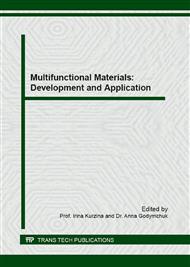[1]
R.S. Mishra, P.S. De, N. Kumar, Friction Stir Welding and Processing, Springer, Switzerland, (2014).
Google Scholar
[2]
L. Shia, C.S. Wua, X.C. Liu, Modeling the effects of ultrasonic vibration on friction stir welding, J. Mater. Process. Technol. 222 (2015) 91–102.
Google Scholar
[3]
S. Amini, M. R. Amiri, Study of ultrasonic vibrations effect on friction stir welding, Int J Adv Manuf Technol. 73 (2014) 127-135.
DOI: 10.1007/s00170-014-5806-7
Google Scholar
[4]
E. Kolubaev, A. Kolubaev, O. Sizova, V. Rubtsov, A. Tolmachev, S. Psakhie, Ultrasonic impact treatment of the welded joint of aluminum-magnesium alloy produced by friction stir welding, AIP Conf. Proc. 1623 (2014) 271-274.
DOI: 10.1063/1.4901486
Google Scholar
[5]
X.C. Liu, C.S. Wu, Experimental study on ultrasonic vibration enhanced friction stir welding, Proc. of the 1st Int. Joint Symp. on Joining and Welding, Japan (2013) 151–154.
DOI: 10.1533/978-1-78242-164-1.151
Google Scholar
[6]
Y. Rostamiyan, A. Seidanloo, Experimental studies on ultrasonically assisted friction stir spot welding of AA6061, Archives of civil and mechanical engineering. 15 (2015) 335–346.
DOI: 10.1016/j.acme.2014.06.005
Google Scholar
[7]
Lai Ruilin, He Diqiu, Liu Luocheng, Ye Shaoyong, Yang Kunyu, A study of the temperature field during ultrasonic-assisted friction-stir welding, Int J Adv Manuf Technol. 73 (2014) 321–327.
DOI: 10.1007/s00170-014-5813-8
Google Scholar
[8]
M. A. Sutton, A. P. Reynolds, D. -Q. Wang, C. R. Hubbard, A study of residual stresses and microstructure in 2024-T3 aluminum friction stir butt welds, J. Eng. Mater. Technol. 124 (2002) 215-221.
DOI: 10.1115/1.1429639
Google Scholar
[9]
L.F. Mondolfo, Aluminum Alloys: Structure and Properties, Butterworth, London-Boston, (1976).
Google Scholar
[10]
E. Bousquet, A. Poulon-Quintin, M. Puiggali, O. Devos, M. Touzet, Relationship between microstructure, microhardness and corrosion sensitivity of an AA 2024-T3 friction stir welded joint, Corros. Sci. 53 (2011) 3026-3034.
DOI: 10.1016/j.corsci.2011.05.049
Google Scholar


